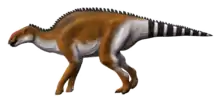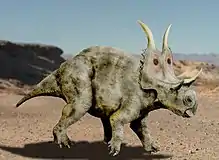Wahweap Formation
The Wahweap Formation of the Grand Staircase-Escalante National Monument is a geological formation in southern Utah and northern Arizona, around the Lake Powell region, whose strata date back to the Late Cretaceous (Campanian stage). Dinosaur remains are among the fossils that have been recovered from the formation.[1]
| Wahweap Formation Stratigraphic range: Campanian, 81–76.6 Ma | |
|---|---|
| Type | Geological formation |
| Unit of | Kaiparowits Plateau |
| Underlies | Kaiparowits Formation |
| Overlies | Straight Cliffs Formation |
| Location | |
| Coordinates | 37.5°N 111.7°W |
| Region | North America |
| Country | |
| Extent | Southern Utah, Northern Arizona |
| Type section | |
| Named for | Wahweap Creek |
Age
The base of the Wahweap Formation has been dated to ~81 Ma based on the presence of a 80.63 Ma date at the base of the middle member. The top of the uppermost member, the capping sandstone, would be similar to the basal age of the overlying Kaiparowits Formation, therefore around 76.6 Ma. The lower member of the Wahweap would date from ~81-80.7 Ma, the middle member would date from ~80.7-80 Ma, and the upper member would date from ~80-78.7 Ma. The capping sandstone is closer to the Kaiparowits Formation in deposition and there would have been a gap between the upper and capping sandstone members of the Wahweap Formation.[2][3]
Paleobiota
Invertebrates
The Wahweap Formation shows a substantial amount of invertebrate activity ranging from fossilized insect burrows in petrified logs[4] to various mollusks that characterize the shell beds. Large fossilized crabs are common at most shell bed sites in the Wahweap,[5] and over 1,900 gastropod specimens (of four likely genera) have been unearthed in the formation's siltstone.[6]
Fishes
In addition to terrestrial vertebrates, freshwater fish fossils have been uncovered from the Wahweap which include bowfin vertebrae,[6] ray teeth,[7] and probable lungfish burrows.[8]
Dinosaurs
Dinosaurs known from the Wahweap include, at least 2 species of hadrosaur, at least two ceratopsians[9] and at least one theropod.[10]
Color key
|
Notes Uncertain or tentative taxa are in small text; |
| Dinosaurs of the Wahweap Formation
| |||||
|---|---|---|---|---|---|
| Genus | Species | Member | Abundance | Notes | Images |
|
A. gagslarsoni |
Upper part of middle |
A hadrosaurid closely related to Brachylophosaurus and Maiasaura |
 Acristavus skull | ||
|
A. hutchisoni |
Lower part of upper |
One partial maxilla. |
|||
| Ankylosauridae[13] | Indeterminate | Upper | Teeth | ||
| Brachylophosaurus[14] | Indeterminate | Uppermost | "Partial limb bones and a partial maxilla." | Different from Acristavus. | |
| Centrosaurinae[15] | Indeterminate | Upper part of lower | Partial skull. | Originally referred to Diabloceratops, but is more derived. | |
| Centrosaurinae[15] | Indeteminate | Upper part of lower | "A partial braincase and a nearly complete parietosquamosal frill." | Also known as "Wahweap Centrosaurine A." | |
| Centrosaurinae[15] | Indeterminate | Uppermost | "Partial frill and some postcranial elements" | Also known as "Wahweap Centrosaurine C." | |
|
D. eatoni |
Middle part of middle |
Two incomplete skulls |
The older specimen from Nipple Butte may not belong to Diabloceratops. | ||
|
L. argestes |
Lower part of middle | A partial skeleton. | |||
|
M. cronusi |
Upper |
A partial skull |
A centrosaurine closely related to Diabloceratops. Previously known as "Wahweap Centrosaurine B." | ||
| Nodosauridae[13] | Indeterminate | ?Lower, Middle and Upper | Teeth, some osteoderms, a cranium(lost), and a partial skeleton | The skeleton was under excavation as of 2013. The cranium was only tentatively identified as a nodosaurid, but can't be confirmed. | |
| Pachycephalosauridae | Indeterminate | Lower part of middle | "Isolated teeth and incomplete frontoparietal dome" | ||
| Saurolophinae[12] | Indeterminate | Middle | Two skeletons, one adult, one juvenile | Probably represents a new distinct taxon. | |
Mammals

A fair number of mammals spanning the lower Campanian are known from the Wahweap as well, including at least 15 genera of multituberculates, cladotherians, marsupials, and placental insectivores.[17]
Trace fossils
Trace fossils are also relatively abundant in the Wahweap, and include vertebrate tracks as well as burrow activity. Tracks preserved in the capping sandstone indicate the presence of crocodylomorphs, which had been previously known in this area only from teeth elements, as well as ornithischian dinosaurs. At least one possible theropod track has been identified in this area as well.[18]
In 2010 a unique trace fossil from the Wahweap was discovered that indicates a predator–prey relationship between dinosaurs and primitive mammals. The trace fossil includes at least two fossilized mammalian den complexes as well as associated digging grooves presumably caused by a maniraptoran dinosaur. The proximity indicates a case of probable active predation of the burrow inhabitants by the owners of the claw marks.[16]
See also
- List of dinosaur-bearing rock formations
References
- Weishampel, David B; et al. (2004). "Dinosaur distribution (Late Cretaceous, North America)." In: Weishampel, David B.; Dodson, Peter; and Osmólska, Halszka (eds.): The Dinosauria, 2nd, Berkeley: University of California Press. Pp. 574–588. ISBN 0-520-24209-2.
- Albright, L. Barry; Titus, Alan L. (2016). "Magnetostratigraphy of Upper Cretaceous strata in Grand Staircase-Escalante National Monument, southern Utah: The Santonian–Campanian Stage boundary, reassessment of the C33N/C33R magnetochron boundary, and implications for regional sedimentation patterns within the Sevier Foreland Basin". Cretaceous Research. 63: 77–94. doi:10.1016/j.cretres.2016.03.004.
- Fowler, Denver Warwick (November 22, 2017). "Revised geochronology, correlation, and dinosaur stratigraphic ranges of the Santonian-Maastrichtian (Late Cretaceous) formations of the Western Interior of North America". PLOS ONE. 12 (11): e0188426. doi:10.1371/journal.pone.0188426. ISSN 1932-6203. PMC 5699823. PMID 29166406.
- De Blieux, Donald D. "Analysis of Jim's hadrosaur site; a dinosaur site in the middle Campanian (Cretaceous) Wahweap Formation of Grand Staircase-Escalante National Monument (GSENM), southern Utah." Abstracts with Programs – Geological Society of America, vol. 39, no. 5, pp.6, May 2007
- Kirkland, James Ian. "An inventory of paleontological resources in the lower Wahweap Formation (lower Campanian), southern Kaiparowits Plateau, Grand Staircase-Escalante National Monument, Utah." Abstracts with Programs – Geological Society of America, vol.37, no.7, pp.114, Oct 2005.
- Williams, Jessica A J; Lohrengel, C Frederick. Preliminary study of freshwater gastropods in the Wahweap Formation, Bryce Canyon National Park, Utah. Abstracts with Programs – Geological Society of America, vol. 39, no. 5, pp.43, May 2007
- Thompson, Cameron R. "A preliminary report on biostratigraphy of Cretaceous freshwater rays, Wahweap Formation and John Henry Member of the Straight Cliffs Formation, southern Utah." Abstracts with Programs – Geological Society of America, vol.36, no.4, pp.91, Apr 2004
- Orsulak, Megan et al. "A lungfish burrow in late Cretaceous upper capping sandstone member of the Wahweap Formation Cockscomb area, Grand Staircase-Escalante National Monument, Utah." Abstracts with Programs – Geological Society of America, vol. 39, no. 5, pp.43, May 2007
- http://geology.utah.gov/surveynotes/articles/pdf/horned_dinos_39-3.pdf
- John Wesley Powell Memorial Museum display, visited April 30, 2009
- Gates, T.A.; Horner, J.R.; Hanna, R.R.; Nelson, C.R. (2011). "New unadorned hadrosaurine hadrosaurid (Dinosauria, Ornithopoda) from the Campanian of North America". Journal of Vertebrate Paleontology. 31 (4): 798–811. doi:10.1080/02724634.2011.577854.
- Gates, Jinnah, Levitt, and Getty, 2014. New hadrosaurid (Dinosauria, Ornithopoda) specimens from the lower-middle Campanian Wahweap Formation of southern Utah. pp. 156–173. In The Hadrosaurs: Proceedings of the International Hadrosaur Symposium (D. A. Eberth and D. C. Evans, eds), Indiana University Press, Bloomington.
- Loewen, Mark A.; Burns, Michael E.; Getty, Michael E.; Kirkland, James I.; Matthew K., Vickaryous (2013). "Review of Late Cretaceous Ankylosaurian Dinosaurs from the Grand Staircase Region, Southern Utah" (PDF). In Titus, Alan L.; Loewen, Mark A. (eds.). At the Top of the Grand Staircase-The Late Cretaceous of Southern Utah. Indiana University Press. pp. 445–462. ISBN 9780253008961.
- Gates, Terry A.; Lund, Eric K.; Boyd, C.A.; DeBlieux, Donald D.; Titus, Alan L.; Evans, David C.; Getty, Michael A.; Kirkland, James I.; Eaton, Jeffrey J. (2013). "Ornithopod Dinosaurs from the Grand Staircase–Escalante National Monument Region, Utah, and Their Role in Paleobiogeographic and Macroevolutionary Studies" (PDF). In Titus, Alan L.; Loewen, Mark A. (eds.). At the Top of the Grand Staircase: The Late Cretaceous of Southern Utah. Indiana University Press. pp. 463–481. ISBN 9780253008961.
- Loewen, Mark A.; Farke, Andrew A.; Sampson, Scott D.; Getty, Michael A.; Lund, Eric K.; O'Connor, Patrick M. (2013). "Ceratopsid Dinosaurs from the Grand Staircase of Southern Utah" (PDF). In Titus, Alan L.; Loewen, Mark A. (eds.). At the Top of the Grand Staircase: The Late Cretaceous of Southern Utah. Indiana University Press. pp. 488–503. ISBN 9780253008961.
- Simpson, Edward L.; Hilbert-Wolf, Hannah L.; Wizevich, Michael C.; Tindall, Sarah E.; Fasinski, Ben R.; Storm, Lauren P.; Needle, Mattathias D. (2010). "Predatory digging behavior by dinosaurs". Geology. 38 (8): 699–702. doi:10.1130/G31019.1.
- Eaton, Jeffrey G; Cifelli, Richard L. "Review of Cretaceous mammalian paleontology; Grand Staircase-Escalante National Monument, Utah. Abstracts with Programs – Geological Society of America, vol.37, no.7, pp.115, Oct 2005
- Tester, Edward et al. Isolated vertebrate tracks from the Upper Cretaceous capping sandstone member of the Wahweap Formation; Grand Staircase-Escalante National Monument, Utah Abstracts with Programs – Geological Society of America, vol. 39, no. 5, pp.42, May 2007




